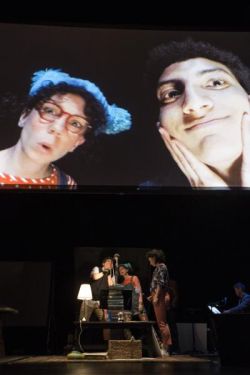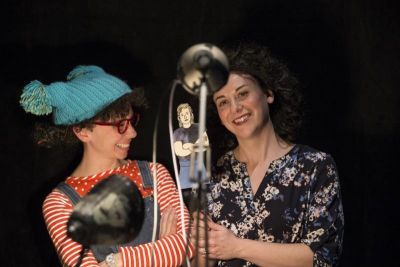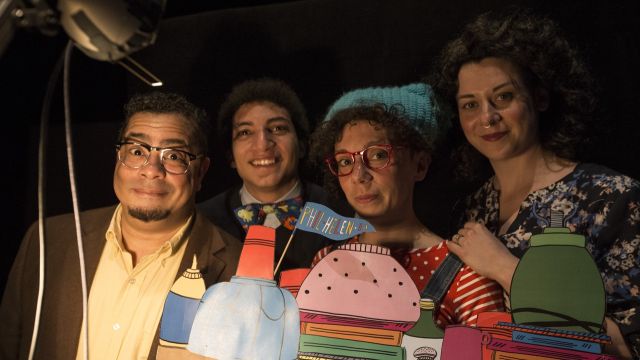Manual Cinema – Magic City
Manual Cinema is a team of film-theatre artists from Chicago, USA. This is their first visit to Australia, and they are quite simply marvelous.
Magic City is the first of two shows they are performing at Her Majesty’s Theatre as part of this year’s Adelaide Festival. It is loosely based on the 1910 children’s novel of the same name by Edith Nesbit, the English author, and co-founder of the Fabian Society, who also wrote other children ‘classic’ novels such as Five Children and It (1902) and The Railway Children (1906).
This adaptation of Nesbit’s Magic City has been relocated to modern day Boston in the USA. It essentially sticks to the same story, although the gender has been changed to that of a parentless young girl called Philomena and her journey of adjustment towards tolerance and acceptance after her older sister Helen marries. This marriage is a major change for the young Philomena, who feels abandoned and is further troubled by the eager attentions of her younger new step-brother, Lucas. To deal with this change she builds a city out of old junk, the Magic City, which also includes the private island ‘Phil-Helen-ia’ made specifically for her, her sister Helen, and Patrick Swayze. Yes – Patrick Swayze.

This is a truly delightful, enchanting, imaginative, clever, funny and simply charming piece of magical theatre. If you have young children and wish to introduce them to the magic of theatre as well as film then you couldn’t do better than taking them to see this show. It is just over an hour long and is wonderful.
Part of the magic is due to the imaginative and thrilling way the story is told, primarily through film that is made up ‘live’ by the actors, musicians, and narrator. This is ‘Manual Cinema’. Using projections, stick figures, puppets, as well a ‘live’ actors and action, the story unfolds through brilliant imagery.
Mixing film and theatre has always been a challenge. Right from the very beginning of film history there were attempts to blend the two art forms, such as Bland Holt’s Australian melodrama The Breaking of the Drought (1902).
References to the early days of film are apparent in the production, with the clever and extremely effective use of ‘Magic Lanterns’, in this case old overhead projectors (the sort I once used in teaching), as well as ‘Tinting’, ie covering a scene with one particular colour (often red) for heightened emotional impact. There are other silent film and early photographic techniques that are wonderfully utilized, such as Camera Obscura and ‘daguerreotype’ – and all this and more is done in full view on-stage. It is fantastic!
Furthermore, in this clever adaptation there are references to other things, which for the curious young mind can be seen as stepping-stones for further discovery. For example, for inspiration and guidance Philomena draws on American flying pioneer, Amelia Earhart; whilst her step-brother, Lucas, learns to harness and focus his excitable nature through the American ‘Harlem Renaissance’ poet Langston Hughes and Jazz. This is not only exciting to watch it is also excellent teaching. Thank you.
Hopefully, the inquisitive, curious and enquiring mind of those young people brought to this show will lead them to find out more about such people as Amelia Earhart and Langston Hughes; parents – be ready and respond.
 But there is more.
But there is more.
At the end of the show the actors step forward and invite the audience, particularly the children, to come up on-stage and work with the actors-puppeteers, experimenting and playing with some of the puppets, and being blasted up on the screen that dominates the stage. Again – not only thrilling for those children who eagerly grabbed this opportunity but also excellent teaching practice.
Being essentially a big kid myself, and fascinated with the challenge of successfully blending film and theatre, which this production did so wonderfully, I also went up on-stage. I wanted to meet the young performer, Maren Celest, who for the entire show is seated in front of a computer on a desk, downstage on the ‘Prompt’ side of the stage. In many ways Ms Celest is the glue that holds the whole show together. She is the ‘Narrator’ of the story, as well as providing the Voices for all the characters, and also singing the song ‘Magic City’. As with the other performers from this Chicago-based ensemble, Ms Celest was gracious, warm, courteous and generous, answering my questions and showing me what and how she contributes and collaborates with the others in this show. Terrific – thank you.
I had such a delightful night in the theatre that I fully intend to go and see Manual Cinema’s other show that will be performed later this week. I encourage all to go – you will not be disappointed; on the contrary you may be amazed; better still – take a young person as this is theatre for them.
Tony Knight
Photographer: Shane Reid
Subscribe to our E-Newsletter, buy our latest print edition or find a Performing Arts book at Book Nook.

